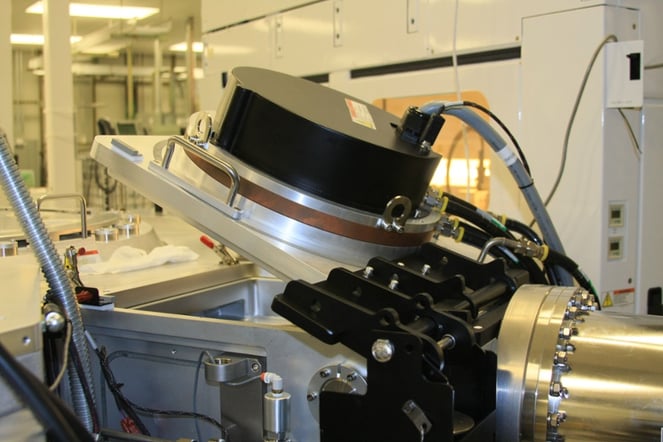
From the retractable keyboard tray you use at work to the cupboard doors in your kitchen, hinges are a part – often unnoticed – of everyday life.
Sometimes, they take on bigger applications, such as industrial refrigerator door in the restaurant kitchen or the counter pass-through at a store.
In these more demanding scenarios, selecting the appropriate type of hinge, whether it's robust lid supports or adaptable gas spring hinges, becomes a significant factor in maintaining functionality and longevity.
The diversity and specific features of these hinges play a pivotal role in meeting the varied needs of both residential and commercial settings.
Selecting the right motion control solution for your application – especially those that require more – isn’t something as simple as going down to your favorite hardware store and finding an appropriately sized hinge. Rather, its about working with an experienced motion control solution provider and weighing several factors to get the right support for your project (no puns intended)
In this quick reference guide, we’ll look at:
- Heavy-duty lid-support hinge considerations
- Heavy-duty gas spring hinges vs. lid stays
- Counterbalance hinges
5 Considerations When Choosing a Heavy-Duty Lid Support
As no two hinge applications are identical, so too must the selection of a heavy lid support provider be tailored to each unique set of requirements and conditions.
Thus, different heavy-duty lid support hinges provide different benefits. Some are better suited for a task that is not within a tight space. To determine the best support provider, consider:
- Location and Space Requirements for Hinge/Lid Stay: Assess the intended location of the hinge or lid stay and the amount of space available for operation. This involves considering not just the space needed for the lid to open and close, but also any additional clearance required for maintenance and user access. Ensure that the selected support mechanism can function effectively within the spatial constraints of the installation site.
- Environmental Conditions and Temperature Exposure: Evaluate the environmental conditions and temperature ranges the lid support will be subjected to. This includes factors like humidity, exposure to chemicals, and temperature extremes. Different materials and designs offer varying degrees of resistance to such conditions. Choosing a support system that withstands your specific environmental conditions helps ensure longevity and reliability.
- Load Bearing Capacity: Determine the weight of the lid or load that the support will need to hold. Consider not only the weight of the lid itself but also any additional forces that may be applied, such as wind pressure or added weight from snow or debris.
- Lid Size and Depth Requirements: Physical dimensions of the lid, including its size and depth influence the type and size of the support mechanism required. Larger or deeper lids may require stronger supports or those with a longer extension.
- Lid Motion Vs. Position: Pivoting loads swivel around a fulcrum. That pivot can be horizontal, such as for a lid, where gravity has a significant impact; or vertical, like a door. With a vertical pivot, the action is perpendicular to the ground and therefore not as impacted by gravity. In the case of a vertical pivot, the focus is less on counterbalance and more on spring assist for the purpose of closure.
Heavy Duty Gas Spring Hinges Vs. Lid Stays + Chart
Like lids, motion control solutions come in many different sized and shapes.
When considering the most suitable options for controlling and supporting moving lids, it's important to understand the differences and applications of gas spring hinges and lid stays.
Gas spring hinges are ideal for lower-cycle hinge use and on a light load. These tend to be relatively quiet as well. Gas spring hinges tend to take up more space than a mechanical spring hinge, which means for those tighter areas this is not the ideal option.
Lid stays are used in certain situations to control the lid open range. These situations include chest lids, open-front desks, and upward-opening doors. Many stays are rated to support a certain number of inch-pounds (in-lbs). The deeper and heavier the lid, the more lifting and holding power that will be required.
Generally, lid stays are an option that is selected because no hinges are needed. However, in the case of torsion hinges, the two can work in tandem to provide a convenient method of controlling the moving lid while avoiding space issues. While this may seem beneficial, the choice to utilize counterbalance hinges can mean better safety and control.
|
Feature |
Gas Spring Hinges |
Lid Stays |
|
Ideal Use |
Lower-cycle, light load |
Control lid open range |
|
Noise Level |
Relatively quiet |
Quiet |
|
Space Requirements |
More space required |
Less space required |
|
Application Examples |
General purpose, less specific |
Chest lids, open-front desks, upward-opening doors |
|
Load Capacity |
Lower capacity |
Rated for specific inch-pounds, suitable for heavier lids |
|
Need for Hinges |
Required |
Not needed, but can work with torsion hinges |
Counterbalance Hinges: Versatile & Effective

Counterbalance hinges can be used for pivoting loads. Some examples of counterbalance hinge use include kitchen appliances, freezer doors, and fold-out furniture. Murphy beds are a great example of the effective use of a counterbalance hinge.
Ergonomic office equipment also often uses a counterbalance hinge, providing easy access to the keyboard or mouse, for example, while helping reduce the risk of repetitive injury when these computer accessories are not within comfortable reach.
Regardless of their location - industrial sites or office spaces, kitchens or hotels, counterbalance hinges provide the right support for objects with considerable weight. This is done with special design specifications to keep some of the weight noticeable to provide easier use.
Vectis DYO App: Help with the Calculations
The Vectis DYO app can help you design the right hinge for your product. By inputting the lid weight, the lid center of gravity to the hinge pivot axis, the horizontal distance and the vertical distance, you can start designing your hinge. From there, the next step is choosing a hinge in the Vectis line.
You can opt for the Vectis200, which offers a torque range of 90 to 200 in-lbs; a Vectis600, which offers a torque range of 160 to 600 in-lbs; a Vectis1200 (torque range 350-1200 in-lbs), and a Vectis1800 (torque range 450-1800 in-lbs).
Setting up an order means using slide bar variables to find the optimum torque curve and also adjusting the open and close feel to your desired parameters. From there, you can make sure you have the right quantity selected and move forward with your order.
While you are figuring out the above specifications, you should also keep in mind that the graph shows the Spring Torque Curve (displayed as an orange line), and that curve can be adjusted using a few of the additional parameters available. It can be set above, on, or below the black line and at different angles. This helps control the spring-based torque amounts applied at every angle.
Talk to Our Expert Weber Knapp Engineers
Contact our experienced engineers to address any unanswered questions regarding the right heavy-duty lid support provider. You can also download the resource below for more information.
.png?width=12000&height=2033&name=WeberKnappLogo_white%20(1).png)



